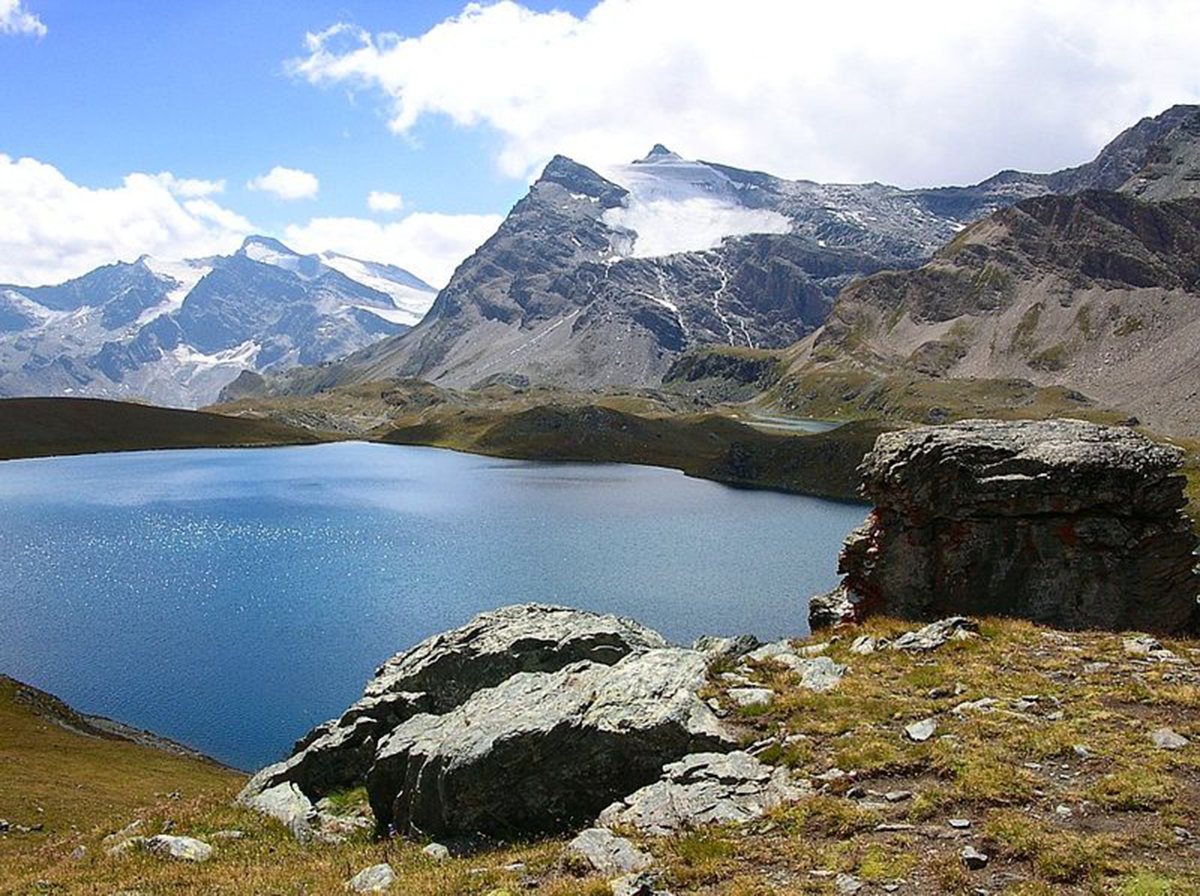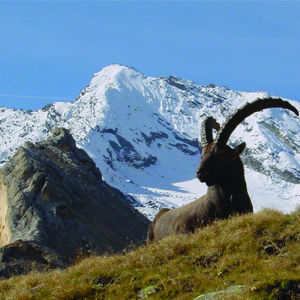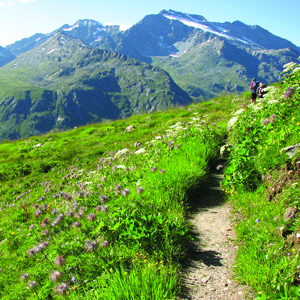
Gran Paradiso National Park
This post is also available in:
 Italiano (Italian)
Italiano (Italian)
Established in 1922, Gran Paradiso is the oldest Italian National Park together with Abruzzo National Park, born a few months later. It straddles Valle d’Aosta and Piedmont and is managed by the Gran Paradiso National Park Authority, based in Turin. On the French side, it borders the Vanoise National Park.
It covers 175.500 acres predominantly found in the mountain areas, encompassing several agricultural settlements rich in artistic, religious, and traditional heritage. In fact, there are many rock carvings, roads and bridges of Roman origin, medieval churches and castles, royal hunting lodges and paths, military buildings, as well as typical alpine structures scattered all over the park. It’s thus possible to often come across the traditional stone buildings with the stables on the ground floor, and rooms or residential facilities on the first floor and above the barn.
Each season offers different sights and sensations. Flowering reaches its peak from mid-June to mid-July: the right time of the year to visit the wondrous Paradisia Alpine Botanical Garden, in Valnontey (a hamlet of Cogne – see dedicated page). In autumn, the woods feature a breath-taking palette of warm and blazing shades, while the chamois mating season begins. In winter, the snow-covered mountains can be enjoyed on many cross-country walking and mountaineering skiing occasions, while spotting the local wild fauna.
The Park offers countless sports, excursion, and recreational activities, including cultural experiences, well-being facilities and top-notch relaxation opportunities.
THE FAUNA
There are many ibex, which have avoided extinction thanks to the 1821 royal decree by the Savoy family in 1821, which actually established the park protected area.
The Parc Animalier of Introd is a specific area packed with chamois, ibex, birds of prey, marmots and many wild species. Inside it, there are also two beautiful lakes full of trouts and chars.
THE VEGETATION
Gran Paradiso National Park protects an area characterized by a predominantly alpine environment. The local mountains have been carved and shaped into the valleys by large glaciers and streams; in the woods, there are many larch trees (Larix decidua), Norway spruces (Picea abies), stone pines (Pinus cembra) and occasional silver firs (Abies alba). Going up slopes, trees are replaced by vast alpine pastures, full of flowers in late spring. At the height of 13.323 ft 4061, rock formations and glaciers appear all over the landscape. The park thus allows discovering different natural environments, of great botanical and landscape value.
THE AQUATIC ENVIRONMENTS
Calm water areas, such as lakes and ponds, as well as rivers, streams, and ditches, are abundant all over the park. They’re inhabited by highly specialized plants, which require soils impregnated with water, or at least rich in moisture.
HUMID ENVIRONMENTS
Swamps and bogs, springs, wet cliffs and grasslands are part of the Gran Paradiso protected area,
Especially above the woods and the alpine pastures; they all feature abundant rock formations and debris on the surface, thus reducing the very soil layer.
In the peat bogs and the marshes, there are several species of grass, rush and sedge, together with orchids and small “carnivorous” plants such as butterworts and sundew.
The most common debris on the ground surface are of schistose origin, relatively humid and, therefore, suitable for plants. Siliceous debris is quite common around the Gran Paradiso massif, offering a peculiar environment made of coarse material, with very little water: up there, only the species which have managed to adapt to such harsh habitat (siliceous flora) can grow; they can also be found on the debris layers of hard limestone, although much rarer in the Park (calcic flora).
The same vegetation is found on the moraines (originated from erosion and accumulation of the glaciers; they are defined as high altitude “cold debris”, since the abundant ice guarantees a good level of humidity, at least at certain depths). Such peculiar vegetation thrives on the very mineral matrix of the soil, rather than on the rocky environment.
ROCKY ENVIRONMENTS
The cliffs or the rocky walls can be seen everywhere in the Park, at different altitudes and not only on alpine and snowy plains. As it happens in the above-mentioned humid environments, we can find plants with peculiar morphological features such as cushion-like bearing which leaves just the flower scape exposed. They also have long root systems, capable of developing among the thin cracks of the rock in search of water.
THE PRAIRIES
In the Park, there are also several steppe grasslands, meadow-pastures, high-altitude alpine pastures, and snowy valleys.
The steppe grasslands are made of herbaceous plant formations (grass) and a few dicotyledons, especially in the area facing Valle d’Aosta; they can be found at relatively low altitudes and are used for grazing sheep and cattle.
Meadows-pastures are those herbaceous formations whose floristic composition is strongly conditioned by the production of forage (obtained by mowing and direct grazing). Quite common in the Park, they’re mainly found near the human settlements and have a thick and homogeneous herbaceous surface made of Graminaceae and Dicotyledons.
The alpine or high-altitude pastures, widespread in the Park, occupy all the areas above the forest line. The floristic composition is variable and conditioned by the nature of the substrate and the altitude.
The snow valleys are depressions in the ground where the snow remains for most of the year, eventually disappearing only for a short time (one to three months at the most). The flora is influenced by the type of substrate (limestone or silica) but is generally made of dwarf willows and Dicotyledons.
WOOD HEDGES
Around the woods, shrubs develop, mainly belonging to three large groups:
1-the willow groves on the banks of the waterways (at low or high altitudes), featuring the dominant presence of different species of shrubby willows.
2-the shrub formations in dry and warm places, mostly made of thorny shrubs such as barberry, raspberry, juniper and brambles.
3-green alder groves, dominated by Alnus viridis, which colonize the slopes of the avalanche gullies, the banks of the alpine streams, and the lower areas of the moraines; there is also some herbaceous vegetation that grows among the alders, mainly consisting of large-leaved and quite tall plants.
Above the woods, the moorlands and some low-altitude wood formations can be found, featuring discontinuous vegetation. There are some small herbaceous plants, lichens and soil mosses; they can be clearly identified in the savin plains (Juniperus sabina). There is also some xerophilous subalpine heath with dwarf juniper, cranberry and bog bilberry; not to mention meso-hygrophilous subalpine heath with rhododendron and bilberry, lingonberry and, once again, bog bilberry. This section of the parks also includes some stretches of windy alpine moorland.
THE WOODS
The woods cover just under 20% of the total surface of the Park and are of great importance, offering shelter to a large number of animal species, as well as protection against the dangers of hydrogeological instability (landslides, avalanches, floods). They are mainly deciduous or coniferous forests.
Broad-leaved woods are made of beeches (Fagus sylvatica), abundant in the section of the park facing Piedmont, but never found in the other one facing Valle d’Aosta. Then there are woods made of sycamore maples (Acer pseudoplatanus) in the gorges, and woods of large-leaved limes (Tilia platyphyllos); those woods are scattered within the park, especially in the most humid areas, on the northern slopes and at lower altitudes.
Chestnut groves (Castanea sativa) can be found as well on in the area facing Piedmont. Those trees grow up to 3.280 ft and are strongly linked to human activities (wood and fruit production). Pioneering and infesting plants can be recognized in relatively recent heterogeneous tree formations: they have developed mainly on the sunny slopes once used for agriculture and livestock feeding. The species mainly found are aspens (Populus tremula), birches, and common hazels (Corylus avellana).
The coniferous woods in the park are made of Scots pine (Pinus sylvestris): they’re much more common in the area facing Valle d’Aosta, on poor, rocky soils exposed to the south.
The Norway spruce forests (Picea abies) are often mixed with larches (Larix decidua) and are probably the most common tree formations in the Park, especially in the middle subalpine level up to 5.905-6.561 ft of altitude.
The undergrowth is made of heath, while the woods of larch (Larix decidua) and stone pines (Pinus cembra) grow at the highest altitudes (up to the very limit of the subalpine plain – 7.217-7.545 ft); the undergrowth is mainly made of Ericaceae, rhododendrons and blueberries.
Finally, the larch woods (Larix decidua) appear mixed with Norway spruce specimens or stone pines, while the undergrowth is very poor when larches prevail.
This post is also available in:
 Italiano (Italian)
Italiano (Italian)
Contatti
Valsavarenche(AO)
011 8606233 Segreteria turistica
info@pngp.it
Altre info
Apertura segreteria al pubblico: da lunedì a venerdì 9-12


